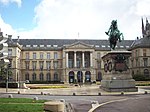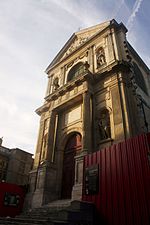Saint-Ouen Abbey, Rouen

Saint-Ouen Abbey, (French: Abbaye Saint-Ouen de Rouen) is a large Gothic Catholic church and former Benedictine monastic church in Rouen. It is named for Audoin (French: Ouen, English: Owen), 7th-century bishop of Rouen in modern Normandy, France. The church's name is sometimes anglicized as St Owen's. Built on a similar scale to nearby Rouen Cathedral, the abbey is famous for both its architecture and its large, unaltered Cavaillé-Coll organ, which was described by Charles-Marie Widor as "a Michelangelo of an organ". With the cathedral and the Church of Saint-Maclou, Saint-Ouen is one of the principal French Gothic monuments of the city.
Excerpt from the Wikipedia article Saint-Ouen Abbey, Rouen (License: CC BY-SA 3.0, Authors, Images).Saint-Ouen Abbey, Rouen
Place du Général de Gaulle, Rouen Quartier Saint-Marc / Croix de Pierre / Saint-Nicaise
Geographical coordinates (GPS) Address External links Nearby Places Show on map
Geographical coordinates (GPS)
| Latitude | Longitude |
|---|---|
| N 49.4425 ° | E 1.0997222222222 ° |
Address
Abbatiale Saint-Ouen
Place du Général de Gaulle
76000 Rouen, Quartier Saint-Marc / Croix de Pierre / Saint-Nicaise
Normandy, France
Open on Google Maps









